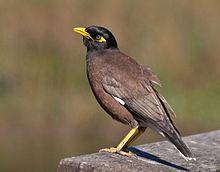Myna
This articlerelies largely or entirely on asingle source.(June 2011) |
| Myna | |
|---|---|

| |
| Common myna(Acridotheres tristis) | |
| Scientific classification | |
| Domain: | Eukaryota |
| Kingdom: | Animalia |
| Phylum: | Chordata |
| Class: | Aves |
| Order: | Passeriformes |
| Suborder: | Passeri |
| Family: | Sturnidae |
Themynas(/ˈmaɪnə/;also spelledmynah) are a group ofbirdsin thestarlingfamily(Sturnidae). This is a group ofpasserinebirds which are native toIranandSouthern Asia,especiallyAfghanistan,India,Pakistan,Bangladesh,NepalandSri Lanka.Several species have been introduced to areas likeNorth America,Australia,South Africa,FijiandNew Zealand,especially thecommon myna,which is often regarded as aninvasive species.It is often known as "Selarang" and "Teck Meng" in Malay and Chinese respectively in Singapore, due to their high population there.
Mynas are not a natural group;[1]instead, the termmynais used for any starling in the Indian subcontinent, regardless of their relationships. This range was colonized twice during theevolutionof starlings, first by rather ancestral starlings related to thecoletoandAplonislineages, and millions of years later by birds related to thecommon starlingandwattled starling's ancestors. These two groups of mynas can be distinguished in the more terrestrialadaptionsof the latter, which usually also have less glossy plumage, except on the heads, and longer tails. TheBali myna,which is critically endangered and nearlyextinctin the wild, is highly distinctive.
Some mynas are consideredtalking birds,for their ability to reproduce sounds, including human speech, when in captivity.
Mynais derived from theUrdu languageمینا(mainā) which itself is derived fromSanskritmadanā.[2][3]
Characteristics
Mynas are medium-sized passerines with strong feet. Their flight is strong and direct, and they are gregarious. Their preferred habitat is fairly open country, and they eatinsectsandfruit.

Plumageis typically dark, often brown, although some species have yellow head ornaments. Most species nest in holes.
Some species have become well known for their imitative skills; thecommon hill mynais one of these.
Species
The following are species of mynas. The coleto and the twoSaroglossastarlings are included because of their position in the taxonomic list.
Jungle and hill mynas
- Yellow-faced myna,Mino dumontii
- Golden myna,Mino anais
- Long-tailed myna,Mino kreffti
- Sulawesi myna,Basilornis celebensis
- Helmeted myna,Basilornis galeatus
- Long-crested myna,Basilornis corythaix
- Apo myna,Goodfellowia miranda
- White-necked myna,Streptocitta albicollis
- Bare-eyed myna,Streptocitta albertinae
- Fiery-browed myna,Enodes erythrophris
- Finch-billed myna,Scissirostrum dubium
- Golden-crested myna,Ampeliceps coronatus
- Common hill myna,Gracula religiosa
- Southern hill myna,Gracula indica
- Enggano hill myna,Gracula enganensis
- Nias hill myna,Gracula robusta
- Sri Lanka hill myna,Gracula ptilogenys
"True" mynas
- Great myna,Acridotheres grandis
- Crested myna,Acridotheres cristatellus
- Javan myna,Acridotheres javanicus
- Pale-bellied myna,Acridotheres cinereus
- Jungle myna,Acridotheres fuscus
- Collared myna,Acridotheres albocinctus
- Bank myna,Acridotheres ginginianus
- Common myna,Acridotheres tristis
- Bali myna,Leucopsar rothschildi
"Gracupica" mynas
- Indian pied myna,Gracupica contra
- Siamese pied myna,Gracupica floweri
- Javan pied myna,Gracupica jalla
The following species are often included in theAcridotheresmynas:
- Vinous-breasted starling,Acridotheres burmannicus
- Black-winged starling,Acridotheres melanopterus
- Red-billed starling,Spodiopsar sericeus
- White-cheeked starling,Spodiopsar cineraceus
References
- ^Zuccon et al. 2006.
- ^"myna".Collins English Dictionary - Complete & Unabridged(11th ed.).RetrievedNovember 22,2012– via CollinsDictionary.com.
- ^"myna".New Oxford American Dictionary.
Sources
- Zuccon, Dario; Cibois, Alice; Pasquet, Eric; Ericson, Per G. P. (2006). "Nuclear and mitochondrial sequence data reveal the major lineages of starlings, mynas and related taxa".Molecular Phylogenetics and Evolution.41(2): 333–344.doi:10.1016/j.ympev.2006.05.007.PMID16806992.
External links
- Myna videoson the Internet Bird Collection
- Recording of a Myna bird in Yogyakarta, Indonesiaoninternet Archive
